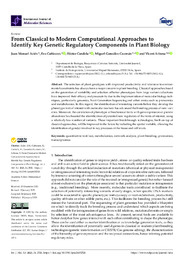Por favor, use este identificador para citar o enlazar este ítem:
https://hdl.handle.net/11000/35309Registro completo de metadatos
| Campo DC | Valor | Lengua/Idioma |
|---|---|---|
| dc.contributor.author | Acién, Juan Manuel | - |
| dc.contributor.author | Cañizares Ramos, Eva | - |
| dc.contributor.author | Candela, Héctor | - |
| dc.contributor.author | Gonzalez-Guzman, Miguel | - |
| dc.contributor.author | Arbona, Vicent | - |
| dc.contributor.other | Departamentos de la UMH::Biología Aplicada | es_ES |
| dc.date.accessioned | 2025-01-26T10:34:48Z | - |
| dc.date.available | 2025-01-26T10:34:48Z | - |
| dc.date.created | 2023-01-28 | - |
| dc.identifier.citation | International Journal of Molecular Science 2023, 24(3), 2526 | es_ES |
| dc.identifier.issn | 1422-0067 | - |
| dc.identifier.issn | 1661-6596 | - |
| dc.identifier.uri | https://hdl.handle.net/11000/35309 | - |
| dc.description.abstract | The selection of plant genotypes with improved productivity and tolerance to environmental constraints has always been a major concern in plant breeding. Classical approaches based on the generation of variability and selection of better phenotypes from large variant collections have improved their efficacy and processivity due to the implementation of molecular biology techniques, particularly genomics, Next Generation Sequencing and other omics such as proteomics and metabolomics. In this regard, the identification of interesting variants before they develop the phenotype trait of interest with molecular markers has advanced the breeding process of new varieties. Moreover, the correlation of phenotype or biochemical traits with gene expression or protein abundance has boosted the identification of potential new regulators of the traits of interest, using a relatively low number of variants. These important breakthrough technologies, built on top of classical approaches, will be improved in the future by including the spatial variable, allowing the identification of gene(s) involved in key processes at the tissue and cell levels. | es_ES |
| dc.format | application/pdf | es_ES |
| dc.format.extent | 23 | es_ES |
| dc.language.iso | eng | es_ES |
| dc.publisher | MDPI | es_ES |
| dc.rights | info:eu-repo/semantics/openAccess | es_ES |
| dc.rights | Attribution-NonCommercial-NoDerivatives 4.0 Internacional | * |
| dc.rights.uri | http://creativecommons.org/licenses/by-nc-nd/4.0/ | * |
| dc.subject | quantitative trait loci | es_ES |
| dc.subject | metabolomics | es_ES |
| dc.subject | network analysis | es_ES |
| dc.subject | plant breeding | es_ES |
| dc.subject | proteomics | es_ES |
| dc.subject | transcriptomics | es_ES |
| dc.subject.other | CDU::5 - Ciencias puras y naturales::57 - Biología | es_ES |
| dc.title | From Classical to Modern Computational Approaches to Identify Key Genetic Regulatory Components in Plant Biology | es_ES |
| dc.type | info:eu-repo/semantics/article | es_ES |
| dc.relation.publisherversion | https://doi.org/10.3390/ijms24032526 | es_ES |

Ver/Abrir:
ijms-24-02526-v3.pdf
1,5 MB
Adobe PDF
Compartir:
 La licencia se describe como: Atribución-NonComercial-NoDerivada 4.0 Internacional.
La licencia se describe como: Atribución-NonComercial-NoDerivada 4.0 Internacional.
.png)